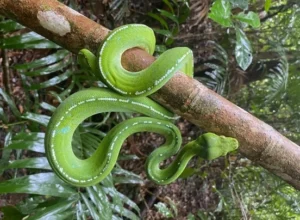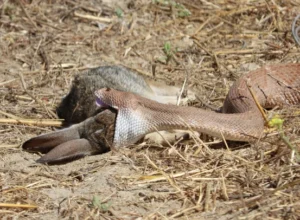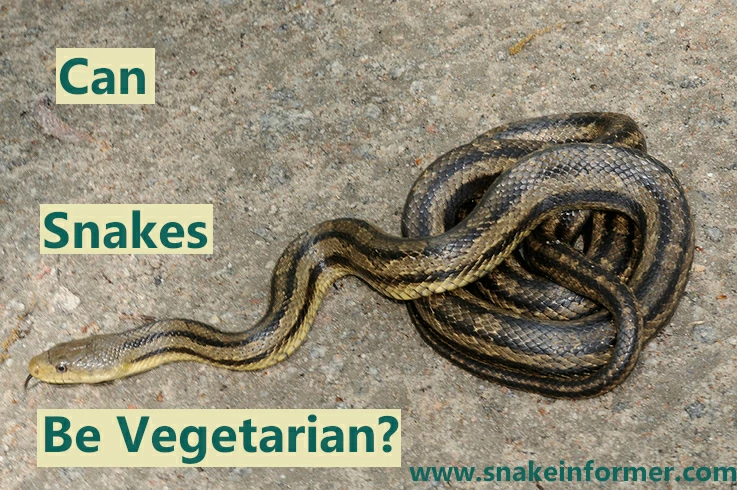Snakes in general, are very adaptable animals. Many species change change their diet, based on the food sources available in their environment.
Snakes can never be vegetarian, or herbivorous. All snakes are obligate carnivores, meaning they only eat animal-based foods and do not eat any plants.
That said, snakes may occasionally ingest plant matter when they hunt and eat prey.
However, this is always an accident. There are no snakes that will intentionally eat plants.
No Vegetarian Snakes Exist
There are over 4,000 snake species in the world. They can be found in a wide variety of habitats, from rainforests to mountainous areas, to deserts.
Different snake species have adapted to their environments and developed strategies to thrive in the areas they live in.
Some snakes live high in trees, while others spend most of their buried in desert sand.

Despite a vast number of differences, all snakes have one thing in common: they are obligate carnivores.
This means their diet is entirely made up of animal products, and their digestive systems are not able to digest plant matter.
The specific diet of snakes can vary, depending on the species, and the habitat they live in.
Some snakes such as the tentacled snake (Erpeton tentaculatum) have a diet consisting almost entirely of fish.
Others such as the common egg eater (Dasypeltis scabra) feed exclusively on birds’ eggs.
Many other snake species (for example, Cottonmouths Agkistrodon piscivorus ) do not have specialized diets and will eat almost any prey they can catch, overpower, and swallow whole.
Snakes Need Meat to Survive
Humans and animals such as pigs, are known as omnivores. This means we have adaptations that enable us to eat, and efficiently digest both animal and plant matter.
We can extract nutrients from meat, and also from fruits, and vegetables.
However, snakes are not the same way. Their bodies do not have the adaptations required to eat and extract nutrients from plant matter.
Like crocodiles, lions, and eagles, snakes’ bodies evolved to live on a diet entirely consisting of meat, and other animal products (like eggs).
They need meat to survive, and can not digest, or extract any meaningful nutrients from plants.
A snake surrounded by fruits and vegetables would starve to death without attempting to eat them.
3 Reasons Why Snakes Can Never Be Vegetarian
Here are 3 reasons why snakes do not eat plants:
1. Snakes Do Not Have the Teeth Structure for Eating Plants
Herbivores, carnivores, and omnivores have different types of teeth, to suit the type of food they eat.
Herbivores like cows and goats, have sharp incisors, and wide, flat molars, designed to tear and grind tough plant matter.
Many carnivores like lions and tigers have sharp teeth for biting and tearing flesh.
Omnivores, on the other hand, have different types of teeth, suited for breaking down both meat and plant matter.
Snakes’ jaws and recurved teeth are highly adapted for catching and holding prey as it is swallowed.
Their teeth are not designed for chewing, so they can not break down plant matter in the way that herbivores or omnivores can.
2. Snakes Swallow Their Food Whole
Snakes do not chew their food, they swallow their prey whole – relying on their very powerful digestive enzymes to break it down over time.

This method of eating is incompatible with a vegetarian lifestyle, where they need to eat plant matter.
Plant matter is tough and needs to be mechanically broken down (chewed) before it is swallowed for further digestion.
All herbivores and omnivores chew plants before swallowing them.
3. Snake Digestive Systems Can Not Digest Cellulose
Plants contain cellulose, a compound that is very hard to digest. Because of this, plant matter needs to spend a lot of time in the digestive system.
Herbivores generally have a long intestinal tract, and a fermentation chamber, that enables them to break down cellulose and absorb as many nutrients as possible.
Omnivores have a flexible digestive system that can digest both meat and plant matter.
However, their digestive systems are not able to digest all types of plant matter like herbivores.
Carnivorous animals like snakes have the simplest digestive system. They have short digestive tracts because meat is dense in nutrients and easier to digest.
Snakes’ digestive systems can not break down cellulose, or extract any meaningful nutrients from plant matter.
Snakes eat plants When Eating Prey
Although snakes are obligate carnivores, they sometimes ingest plant matter unintentionally.
The most common way snakes ingest plant matter is through the stomach contents of their prey.
For example, a snake that eats a mouse can ingest seeds, fruits, or vegetables that the mouse had recently eaten.
Another way snakes often ingest plants is when plant matter attaches to the prey they are eating.
For example, if a snake is eating a bird, then grass, leaves, or small herbs become attached to the bird’s feathers and get swallowed along with the bird.
Ingesting small amounts of plant material is generally not harmful to snakes.
In most cases, the plant matter is passed in their droppings, largely undigested.
Conclusion
There are over 4,000 known snake species in the world, and not a single species is vegetarian.
All snakes are obligate carnivores, and need to eat meat or other animals products such as eggs, to survive.
Snakes do not have the ability to break down plant matter or extract any nutrients from it.
When snakes sometimes ingest plants as they eat prey, the plant matter is not digested and is typically passed nearly intact.
Snake bodies evolved to live off an entirely carnivorous diet.
Hi, my name is Ezra Mushala, i have been interested animals all my life. I am the main author and editor here at snakeinformer.com.

